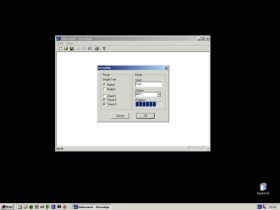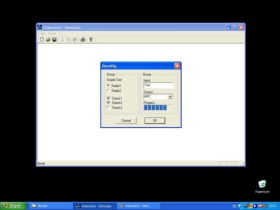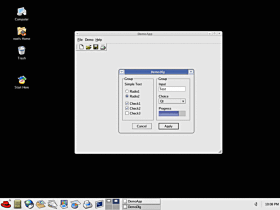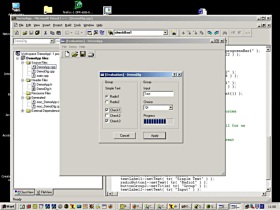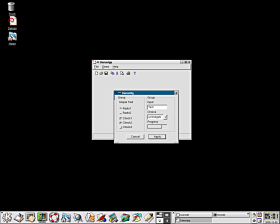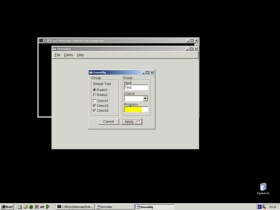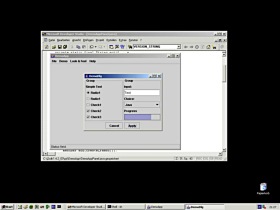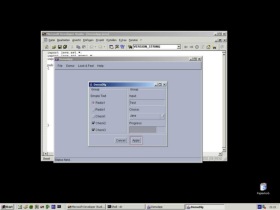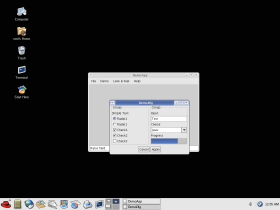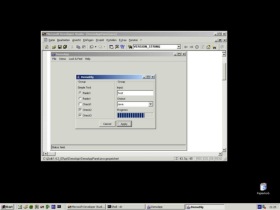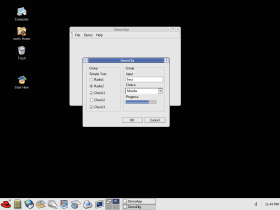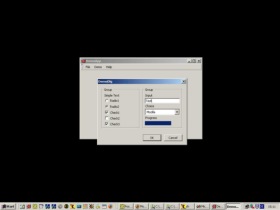![[Photo of the Author]](../../common/images2/MichaelTschater.jpg)
by Michael Tschater
<tschater/at/web.de>
About the author:
Michael is primarily busy with hardware related software
development (firmware). For his current project an additional
decision on the strategy of the development environment - to be
utilized for the programming of the front-end of his firmware -
has to be made.
Translated to English by:
Jürgen Pohl <sept.sapins/at/verizon.net>
Content:
|
Platform Independent Software Develoment
![[Illustration]](../../common/images2/article350/osindep.gif)
Abstract:
Almost all equipment used in industry may be controlled over a
network. The user interface runs on off-the-shelf hardware and
works as a simple client, receiving and sending data, not time
critcal (e.g. initializing parameters and measurement results).
In the following diagram this is shown in green:
![[gui frontend]](../../common/images2/article350/frontend_en.png)
Software projects often require an answer to the question
which operating systems shall be supported. While the readers
of this magazine tend to lean toward Linux, also other
operating systems (mostly Windows) are requested. In principle,
the operating system to be used does not present a dominating
issue for the application; the user has to be able arrive at
the results intuitively.
The following article shall demonstrate that a decision on a
specific platform is not required since it is feasable to write
software which can be compiled for various operating systems.
This article shall be limited to PCs with Linux and Windows. It
should be possible to use the applications also on Mac and
MacOSX but this could not be demostrated due to missing
hardware.
_________________ _________________ _________________
|
With platform-independent libraries we differentiate between
two approaches to produce controls in dialogs:
- Native libraries: For the display of elements the
corresponding routines of the operating system are utilized.
This assures that all controls appear like the standard
application of the operating system. A native library
presents controls differently under Linux than under Windows
2000 or XP.
- The second possibility is to program an appropriate look
& feel, meaning all controls are to be displayed by the
library and appear identical in all operating systems.
Besides the technical quaracteristics of the libraries
additional operational factors play a role which shall be
compared:
- Development environment: an integrated development
environment (e.g. GUI builder, makefile generator) simplifies
the software development.
- Documentation und support: immediate help in case of
occurring problems.
- Costs: While most libraries are freely available for
private use, for commercial applications sometimes costs
inccur. For fundamental decisions on software projects such
costs have to be justified to the decision makers.
- Actual costs for the porting between systems
In an actual case another issue has to be taken in
consideration; this does, however, not apply to all projects:
- The software produced shall utilize native controls to
integrate seemlessly into the existing system architecture.
The user should not be able to identify differences between
new and the existing software on the system.
By displaying the libraries in a layer-model the following
picture emerges:

Programming Languages
The first criteron to be selected is the programming language.
There are several choices which will be discussed below:
- C/C++ libraries
- Java
- Kylix
- Smalltalk
- Mozilla
The alternatives to C and C++ will be explained more in detail
since they are less established with software developers.
A Sample Application
To be able to compare the various software packages a sample
application, using all libraries, shall be generated. The
implementation of the application does not possess any
functionality but it shows the most important controls. For the
windows page pure Windows software will be created (Visual C++
6.0, MFC Class-Library), the other packages will be compared to
it in regard to look & feel. As linux distribution I will
use RedHat Fedora Core 2 and Debian 3.0.
Windows 2000 and Windows XP Screenshot (source code for
Visual C++ here
(win32_src.zip)).
C/C++ Libraries
Trolltech Qt
Qt is a class library of the Norwegian company Trolltech for
platform-independant programming with C++. The Linux windows
manager KDE is based on the Qt package. Originally, Qt was
under a license which was not acceptable for many Linux users.
For this reason the GTK+-library was developed, which is the
basis for the Gnome Windows Manager. In the meantime, the
Linux-version, as well as the MacOS-version, is available under
the GPL, including source codes. Qt for Windows is still
available commercially. A time-limited test version for
evaluations may be downloaded from the webpage - it will be
differentiated between commercial application or academic use.
In the following the commercial evaluation version will be
explained. This version requires registration.
Besides the versions for Windows, Linux(Unix) and Mac an
embedded version is available, it runs on embedded Linux
variants and offers a leaner window administration.
The installation under Linux completes as expected without any
problem. Included is the GUI generator Qt Designer. The
detailed documentation example projects, quick start guide and
class overview. Qt Designer generates as output an XML
description of the GUI. Using the Qt-Tool qmake you can
generate a valid Makefile from the XML description. This
Makefile generates then from the GUI description C++ source
code (Qt-Tool: uic) and calls the Meta Object Compiler
(Qt-Tool: moc). The later translates Qt specific language
extentions into C++ source code. After that a standard make
procedure to compile the executable can be used.
The following sequenz is needed to generate the source files
manually (Input file is MyDialog.ui):
- uic MyDialog.ui > MyDialog.h
- uic -impl MyDialog.h MyDialog.ui > MyDialog.cpp
- moc -o moc_MyDialog.cpp MyDialog.h
Linux and Windows 2000 Screenshot (source code for QtDesigner
here
(qt_src.tar.gz)
Qt Overview
Name:
|
Trolltech Qt
|
Version:
|
3.3.2
|
Operating Systems:
|
Linux, Win32, MacOS, Solaris, IRIX, AIX, HP-UX
|
Programing language:
|
C++
|
License:
|
Linux: GPL; Windows: proprietary License
|
| Advantages: |
- base library for KDE Windows Manager in Linux
- installation packages in all standard distributions
(installation very simple)
- generic controls under Windows
- mighty development environment(s)
- proven
- migrations support for Win32 MFC applications
allows incremental conversion of MFC source code.
|
| Disadvantages: |
- possible license costs (expensive)
- Evaluation software produces errors during the
installation under windows
|
Development environment:
|
e.g. QtDesigner, KDevelop
|
| WWW: |
http://www.trolltech.com |
Documentation:
|
manuals, tutorials, mailing lists
e.g. http://doc.trolltech.com/3.3/index.html
|
Reference projects:
|
- KDE Desktop (Default e.g. with SuSE)
- Opera Browser
- Photoshop Album
|
Distribution:
|
very wide spread
|
wxWidgets
The wxWidgets toolkit is available since some 12 years, but
only a few month ago the package got its today's name. The name
wxWindows, used until that time, was abandoned after "talks"
with Microsoft. wxWidgets includes a huge collection of classes
for all application areas. The list of reference applications
demonstrates the maturity of the software package.
Programming is being done in C++, it is similar to Visual C++
under Windows.
A disadvantage is that you get with wxWindows2.4.2 under RedHat
Fedora Core 2 errors when compiling the example programs. The
cause are GTK+ calls which are declared private in the from
RedHat patched GTK+ version. Calling those functions is
therefore not allowed. However those are minor problems.
Everything will run without problems when the standard GTK+
library is used. Under Debian everything worked right away.
The installation under Windows worked without problems.
Linux (source code here) and Windows 2000 (source code
für Visual C++ here) Screenshot.
Overview Of wxWidgets
Name:
|
wxWidgets
|
Version:
|
2.4.2
|
Operating systems:
|
Linux, Win32, embedded devices
|
Programming Language:
|
C++
|
License:
|
|
| Advantages: |
- simple handling (many examples).
- very good documentation.
|
Disadvantages:
|
- Problems with the combination: Fedora Core 2 -
wxWindows2.4.2
|
Development environment:
|
|
| WWW: |
http://www.wxwidgets.org
|
Documentation:
|
manuals, tutorials, mailing lists, wiki
e.g. http://wiki.wxwidgets.org |
Reference projects:
|
AOL Communicator |
Distribution:
|
not wide spread
|
GTK+ (with gtkmm)
The acronym stands for "The GIMP Toolkit". The two well-known
projects are the Gnome Windows Manger - part of any Linux
standard distribution - and the graphic application GIMP. Gnome
is the second major desktop environment - besides KDE (see Qt)
- under Linux. It is the default environment of many
distributions . With the introduction of GTK+ version 2 the
look & feel has been substantially improved.
One particularity of GTK+ is its complete implementation in C.
Consequently, the GUI builder glade2 produces C-code. By
using gtkmm (formerly GTK--) programming can also be
done in C++.
Contrary to the professional appearance of GTK+ for Linux,
'GTK+ for Win32' is not impressive. Clicking on the link on the
GTK+-mainpage immediately results in the warning "The
program(s) might crash unexpectedly or behave otherwise
strangely ". (But of course, so do many commercial programs
on Windows.) The stability seems to depend a lot on the
machine, display drivers, other software installed or not
present (status 2004-09-06). The courageous software developer
clicks on the download page anyway and faces a long list of
individual software components for downloading. For a
comprehensive package, one searches in vain. Instead of that an
instruction on how to install a number of software components
can be read and to return to the download page if some specific
components are missing. This matches the statement of the 'GTK+
for Windows' webpage: "You are expected to be quite experienced
to be able to use GTK+ in your own programs. This isn't Visual
Basic." After installing the initial components and an
unsuccessful attempt to start one of the sample applications,
most of the developers may have lost their desire to get deeper
into it. The very unprofessional presentation of the 'GTK+ for
Win32' components disqualify the software 'package' for any
professional application.
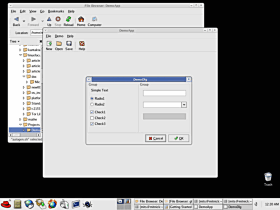
GTK+ Screenshot for Linux (source code for glade2
here (gtk_src.tar.gz))
GTK+ Overview
Name:
|
GTK+ - The GIMP Toolkit
|
Operating systems:
|
Linux, Win32
|
Programming languages:
|
C (C++ mit gtkmm)
|
License
|
LGPL
|
Advantages:
|
- base library for Gnome Windows Manager under
Linux
- installation package included in all standard
distributions (installation very simple)
- generic controls under Windows
- well-proven (under Linux)
|
Disadvantages:
|
- Win32 implementation is unwieldy, does not run
stable (status 09-2004)
|
Development environment:
|
e.g. 2glade (GUI Builder), Anjuta |
| WWW: |
http://www.gtk.org |
Documentation:
|
manuals, tutorials, mailing lists
e.g. http://developer.gnome.org/doc/API/2.0/gtk/index.html
|
Reference projects:
|
- Gnome Desktop
- GIMP
- Gnumeric
|
Distribution:
|
Linux: very wide spread, Windows: marginal
distribution
|
FLTK
FLTK Toolkit ((Fast, Light Tool Kit) is a largely unknown
package, it was implemented as successor of XForms. The
complete sources are being offered for downloading from the
program's website. The size of 2.3MB (Linux) or 3MB (Windows)
proves its name. Installation under Linux without a hitch:
unpacking and run 'make', finished. Subsequently the
user has libraries, sample applications, the GUI builder
"fluid" and a programming handbook at his (her)
disposal. Obviously the number of classes at disposal is
smaller than those of the heavy-weights of Qt and wxWindows.
The classes included cover the GUI domain, meaning: windows,
menus, controls, OpenGL and display of pictures. Classes for
network communication and such are not included.
The installation under Windows was more complicated. When using
the Visual C++ Development Environment only the main project
needs to be translated. This causes however problems with the
graphic libraries. A simple solution is to uncomment them in
the config.h configuration file. A second Windows speific
feature is that the DEBUG version of the FLTK library opens
always an additional DOS window. This ensures that programs
which are started from the command line will be able to write
to stderr and stdout.
All together the FLTK Toolkit leaves the impression of being
well thought-out. The documentation emphasizes the small size
of the executables (80kb for a "hello world") and lean fast 2D
and 3D graphics (OpenGL). Furthermore, the good portability
shall be mentioned.
Linux and Windows 2000 (source code hier
(fltk_src.tar.gz) here), screenshot.
FLTK Overview
Name:
|
Fast Light Tool Kit |
Version:
|
1.1.5rc2
|
Operating systems:
|
Linux, Win32, MacOS
|
Programming language:
|
C++
|
License:
|
LGPL
|
| Advantages: |
- a very lean library
- Source code including documentation and development
environment "fluid".
- good OpenGL support (was not tested)
- generic controls under Windows
|
Disadvantages:
|
- Installation under Win32 (Visual C++) not without
problems
- The fluid development environment does not run
stable under Windows.
|
Development environment:
|
e.g. fluid (GUI Builder)
|
| WWW: |
http://www.fltk.org,
Download: http://freshmeat.net/projects/fltk/
|
Documentation:
|
Manuals, Tutorials, Mailing Lists
e.g. http://
|
Reference projects:
|
|
Distribution:
|
low distribution, mostly unknown even amongst software
developers.
|
FOX Toolkit
The Fos Toolkit claims to be the fastest available toolkit. It
offers a large number of GUI elements and an OpenGL interface.
The installations completed under Windows and Linux without any
problem. Detailed documentation and example projects are
available. A class overview is not included in the version
presented here but is available online.
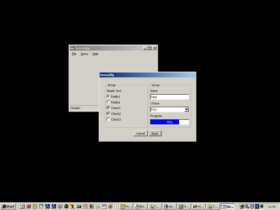
Windows 2000 Screenshot (Source code hier
(fox_src.zip))
FOX overview
Name:
|
FOX Toolkit |
Version:
|
1.2.9
|
Operating systems:
|
Linux, Win32
|
Programming languages:
|
C++
|
License:
|
LGPL
|
| Advantages: |
|
Disadvantages:
|
|
Development environment:
|
|
| WWW: |
http://www.fox-toolkit.org
|
Documentation:
|
Manuals, Tutorials, Mailinglist |
Reference project:
|
|
Distribution:
|
low distribution |
Other possibilities
In addition to the above mentioned libraries I would also like
to mention the following projects which I will however not
discuss further:
- GNUstep [http://www.gnustep.org/]: Limited usability
under windows
- Visual Component Framework [http://vcf.sourceforge.net/]:
No complete Linux version available
JAVA
In 1995 the company Sun introduced a new programming language.
Besides the customary desktop-PC Java was planned for
industrial products (coffee machines, toasters, etc.). The main
breakthrough came initially through internet applications
(applets) in connection with webbrowsers. In the meantime, Java
is being used for standalone applications, for which it is well
suited for its variety of features.
Below we will itemize and explainin short the most important
features of Java.
Platform-independant
Java is platform-independent. Java applications consist of
byte-code which may be interpreted by a virtual engine. Thus,
the applications are able to run on any hardware for which a
virtual engine exists. Interpretation by a virtual engine means
a lower processing speed, compared to compiled software. To
counter this disadvantage, improvements have been developed,
like just-in-time compilation (JIT), which translates program
instructions of the virtual engine into instructions for the
physical machine. The result in this case is an aligned program
in memory, which can be executed rapidly without
interpretation. Aditional analysis of the runtime behavior with
Hotspot-technology results in additional improvements.
Object Orientation
Java is object oriented. The developer of the object
orientation language were inspired by Smalltalk. Presumably for
performance reasons there are still primitive types of data
which are not administered as objects.
Language Syntax
The language syntax is similar to the one of C and C++,
however, bug inducing inconsistencies were not adopted. One
principle for the development of the language was to combine
the best concepts of the existing programming languages.
Some examples:
- no pre-processor. Pre-processor and header files are no
longer necessary since all information is being read directly
from the class files. .
- pointer: Java does not use pointers, references are used
instead. A reference represents an object.
- garbage-collector: to prevent problems with creating and
deleting objects, the object administration is being handled
by the Java runtime-environment. By leaving the active array,
the objects are automatically deleted. Objects or memory
arrays, which are not enabled, as well as false destructors
are being prevented by this technique.
- exeptions: contrary to the treatment of exceptions in C++
Java exceptions are used more intensely, they are often
mandatory.
Class Library
Java includes an extensive class library: JFC (Java Foundation
Class) for the generation of surfaces. (The code name
Swing has caught on.)
Security
Java code is initially being checked by a verifier for
structural correctness and security of types. A
security-manager watches the accesses to the periphery. Any
security problems are reportet as exceptions of the runtime.
Suitability for Projects
The advantages mentioned have side effects which render Java
not wise for all projects. These properties are no mistakes or
weaknesses but they were consciously not implemented, they
belong to the philosophy of the language.
Amongst them are e.g.:
- platform-specific periphery accesses
- direct hardware accesses
- intervention in the operating system
Java Development Kit (JDK)
The Java Development Kit can be downloaded from Sun's
internet site. It includes a basic scope of applications, java
classes and online documentation. The applications are a
compiler, a debugger, an applet-viewer, as well as a variety of
auxilliary programs, necessary to generate and test Java
applications and Java applets. This kit offers only the most
essential, the compiler needs to be run by command line. In
addition, the package contains the Java Runtime Environment
(JRE, includes the virtual engine), which is required to excute
the byte code. The documentation finally describes the whole
API.
JHelloWorld
With the help of standard JDK the mandatory "hello
world"-application shall be implemented.
Step 1: Generation of the source code.
sh>vi Helloworld.java
public class HelloWorld {
public static void main (String[] args) {
System.out.println("Hello World!");
}
}
File name and class name must match.
Step 2: Translation
sh>javac Helloworld.java
Step 3: Start application with the use of the virtual engine.
sh>java Helloworld
JavaScript und Java
JavaScript and Java are often assumed to have similiarities.
That is basically wrong. JavaScript was originally developed by
Netscape as a script language to be embedded in HTML. It is not
a self-contained programming language, it depends on the
browser application. The name JavaScript is more to be seen as
a marketing gag .
Attempts to Standardization
Up to now all attempts to standardize Java have failed. Reason
for this may be Sun's reluctance to relinqish exclusive control
over further development of the Java standards.
Dekompilierung
A problem might be that applications can be de-compiled.
Despite all security it is at the moment possible to convert
the Bytecode back into source code. This is possible because
the Bytecode is written for a virtual processor und contains in
contrast to traditional assembler important additional
information. The additional information makes it much easier to
de-compile the code. You can therefore not hide a propriatary
API or special knowledge in the code.
Miracle Language Or Short-lived Hype
The Java concept was seen at the beginning as the ultimate
answer to all platform independent development. However the
original hype has disappeared. There are version conflicts
between the different Java machnines and execution speed is an
issue. Many companies went after first trials back to stnadard
C++ Programming. The increased numbers of downloads seen by the
wxWidgets developers is one proof for this.
An intersseting Website in this context is:
http://www.internalmemos.com/memos/memodetails.php?memo_id=1321
where employs from Sun provide arguments against Java.
GUIs with Java
Java offers by default 2 possibilities to program graphical
interfaces:
- Jave comes with a rich class library (JFC, Swing). No
oberating system functions are used here. All Widgets are
draw with Java instructions. This makes it possible to change
the look and feel at runtime. This can be seen in the
screenshots below.
- The basic AWT functions. AWT does not have complex
elements like e.g trees it is therefore not suitable for most
applications.
Java Screenshots im Metal-, Motif- und GTK+ Look &
Feel (Quellcode hier
(java_src.zip))
Java Screenshot with Windows Look & Feel under Windows
2000 and Windows XP (idential source code)
As all common used browsers support Java. Applications can
therefore also be written such that they run as so called
applets inside a Webbrowser. This technology can e.g be used
for embedded technologies where the Java-Bytecode is downloaded
from a webserver which is integrated in the application.
The following screenshot shows the identical application as a
Java-Applet integratet into a webpage.
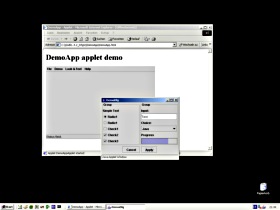
Java screen shot with the example application as an Applet
(code here
(java_applet.zip))
SWT and Eclipse
Eventhough Java offers similar GUI elements as other toolkit
developers where complaining about them. The biggest problems
where insufficient execution speed and lack of fuctionallity.
IBM developed as an alternative the Standard Widget Toolkit
(SWT) which allows the use of native GUI elements under Java. A
refernce project is the also form IBM developed IDE Eclipse
which offers platfrom independent development tools. The
toolkit and the development environment are both free software.
Abbreviations used in context with JAVA
| JDK (Java Development Kit) |
The complete Java package to generate Java
applications consists of application, Java classes and
documentation.
|
JRE (Java Runtime Environment)
|
comprises the virtual engine, it is mandatory for the
use of Java applications.
|
J2ME (Java 2 Micro Edition)
|
Java for devices with limited resources.
|
J2SE (Java 2 Standard Edition)
|
Java for the desktop (Linux, Windows, ...)
|
J2EE (Java 2 Enterprise Edition)
|
Java for the generation of multi-layer
client/server-applications as well as Java-servlets and
Java server-pages.
|
| JFC (Java Foundation Class) |
Classes to develop GUIs (->Swing) |
Java Overview
Name:
|
JAVA 2 PLATFORM STANDARD EDITION DEVELOPMENT KIT
5.0 |
Version:
|
5.0
|
Operating systems:
|
- Linux, Windows, Solaris (SUN)
- Linux, Windows, AIX, Solaris (possibly MacOS,
OS/2, FreeBSD, Amiga, BeOS) (Jikes -> IBM)
|
Programming language:
|
JAVA
|
License:
|
proprietary license (SUN)
|
| Advantages: |
- robust language (many sources for errors are
eliminated by the concept of the language).
|
Disadvantages:
|
- proprietary language, controlled exclusively by
Sun
- virtual engine, must match the target
platform
- slow speed of execution
- SWT programming is more complex than Swing
|
Development environment:
|
e.g.. Eclipse
|
| WWW: |
http://java.sun.com |
Documentation:
|
manuals, tutorials
general: http://java.sun.com/j2se/1.5.0/docs/,
http://www-e.uni-magdeburg.de/mayer/java.html
SWT: http://eclipse-wiki.info/SWT,
http://www.java-tutor.com/java/swtlinks.html
|
Reference projects:
|
|
Distribution:
|
very wide distribution
|
Kylix
Kxlix is a cross-platform development environment for Linux and
Windows. With the help of Borland's CLX library (Component
Library for Cross-platform) applications may be developed under
Delphi and C++, which are able to run under both platforms.
According to a report of the wikipedia homepage (Link here) this library is
only a wrapper for the previously described Qt library. In
addition, the Kylix IDE is obviously a wine-based
non-native Linux-application (Link here)
whose executables have to linked to libwine. Considering
all this, Kylix may not make much sense for C++ developers
since the use of Qt with a free IDE is more straightforward.
Kylix Overview
Name:
|
Kylix
|
Version:
|
3
|
Operating systems:
|
Windows, Linux
|
Programming language:
|
Delphi, C++
|
License:
|
Proprietary software
|
| Advantages: |
- develoment under Delphi and C++
|
Disadvantages:
|
|
Development environment:
|
Kylix
|
| WWW: |
http://www.borland.de/kylix |
Documentation:
|
|
Reference projects:
|
|
Distribution:
|
not wide spread
|
Smalltalk
Smalltalk is a classic amongst the programming languages. It
was developed in 1969/70 by Xerox and is until today a good
example for an object oriented language. Everything is an
object in smalltalk. There are no simple datatypes. Smalltalk
works like Java and .Net (see below) in a virtual machine. The
syntax tries to be close to spoken English but is totally
different from any other programming language. Smalltalk used
to be programmend already from the beginning in a graphical
environment. Smalltak was about 10-15 years ahead of its time.
Smalltalk was quite successful until Java came.
Here the 'Hello world !' programm under smalltalk:
Transcript show: 'Hello world !'; cr.
Smalltalk is still used today. The most widely available
variant is Smalltalk-80 (standardized in 1980). A powerful
development environment is e.g Squeak.
Overview of Smalltalk
Name:
|
Smalltalk (e.g. Squeak)
|
Version:
|
3.6
|
Operating systems:
|
Windows, Linux, Solaris, MacOSX, Darwin
|
Programming language:
|
Smalltalk
|
License:
|
Open Source
|
| Advantagese: |
Totally object oriented |
Disadvantages:
|
Smalltalk is pushed asside by Java and has a
significantly smaller user base. |
Development environment:
|
e.g. Squeak
|
| WWW: |
http://www.smalltalk.org |
Documentation:
|
|
Reference projects:
|
|
Distribution:
|
not wide spread |
Mozilla
Mozilla? A web browser? How can you program with a web browser?
Mozilla is not only a web browsers but also a platform
independent Framework that includes different standards such as
the XUL (XML based interface language). XUL is used to define
the structure and content of an application. All files are used
in clear text. Mozilla does not distinguish between programms
and webpages.
If you enter the following string into the URL field of mozilla
then the browser itself will be shown:
chrome://navigator/content
The following code displays a button in the Mozilla browser
which will open a window with the text "Hello World" when you
click on it:
<?xml version="1.0"?>
<!-- Beispiel XUL Datei -->
<window
xmlns="http://www.mozilla.org/keymaster/gatekeeper/there.is.only.xul">
<box align="center">
<button label="Push" onclick="alert('Hello World');" />
</box>
</window>
Software development with mozilla is very differnt from
classical software development. Mozilla has many innovations
such as the seperation of the application and its presentation.
This makes it possible to change the look of the application
("Themes"). Successful projects such as the firefox web browser
show that it is a robust framework.
Linux und Windows 2000 screenshot (source code here
(moz_src.tar.gz)).
Overview Of Mozilla
Name:
|
Mozilla
|
Version:
|
1.6
|
Operating systems:
|
Windows, Linux,
|
Programming language:
|
XUL
|
License:
|
Mozilla Public License, Netscape Public License |
| Advantages: |
- innovative concepts
- support for many web standards (JavaScript,
Stylesheets,...)
- applications run in the browser or
standalone
|
Disadvantages:
|
|
Development environment:
|
|
| WWW: |
http://www.mozilla.org
|
Documentation:
|
Manuals, tutorials, mailing lists. E.g
www.xulplanet.com |
Reference projects:
|
Mozilla firefox |
Distrubution:
|
widely distributed, but rarely used for software
projects.
|
Microsoft's Answer
In the meantime, Microsoft has of course recognized the signs
of time and introduced it's own approach. Under the name of
.NET a platform was developed, which, last not least, shall
reduce the migration of software developers to the competing
Java platform. A closer look reveals indeed many parallels of
the competitors, even though they are concealed by differnt
names. The equivalent to Java's 'Bytecode' is named C#
'Intermediate Language' MSIL).
What is .NET ?
.NET is a proprietary Microsoft technology which shall be the
base for all future Microsoft products. Support for the until
now favored MFC-library for Visual C++ was abandoned with the
introduction of .NET. .NET shall simplify the the development
of network- and internet-applications; many ideas of Java were
adopted. It supports object-oriented programming and is
provided with a single class library which may be utilized by
several programming languages (C#, VB.NET). That means, the
'Intermediate Language' - which accesses the target hardware -
is being generated from the program code ( compare Java
Sourcecode -> Java Bytecode -> virtual engine ->
physical hardware)..
Future versions of Windows are to be supplied with the .NET
framework.
What Is Visual Studio .NET ?
Visual Studio .NET is a programming environment to simplify the
development of .NET-.software, but it is not mandatory.
Differences Between Visual Basic (VB) And VB .NET
Even though VB.NET - for reasons of compitability - supports
many original VB-functions and the syntax of the language was
maintained, it is a full-blown new programming language.
Which Programming Language Is The Best Suitable?
Since the VB.NET-source code and the C#-source code are
translated into the MSIL, the programming language does not
make a difference. There are, for example, no differences in
speed between C#-code and VB.NET-code. The C# compiler should
be the more suitable tool since it was developed specifically
for the .NET framework.
.NET And Linux
Despite the platform-independant approach, Microsoft will most
likely not develop a Linux .NET-variant, which is the reason
why a developer team - close to Miguel de Icaza (Ximian:
Evolution) - is engaged with this task. The open source package
Mono, version 1.0, is in the meantime available.
Overview Of .NET
Name:
|
Microsoft .NET-Framework
|
Version:
|
|
Operating systems:
|
Windows, Linux
|
Programming language:
|
C#, Windows: VB.NET
|
License:
|
proprietary license
|
| Advantages: |
|
Disadvantages:
|
- proprietary software
- no Linux .NET Version available
- completely new API
|
development environment:
|
Visual Studio .NET
|
| WWW: |
|
Documentation:
|
|
Reference projects:
|
|
Distribution:
|
Low distribution at present
|
Summary
Prior to the final evaluation, the task to be accomplished
shall again be referred to: the goal is the development of a
front-end, which shall communicate by network with the
connected hardware. For this the source code shall able to be
translated in the Linux- and the Win32-platform. The
application shall not be distinguishable from existing software
on the system. With this task the view of the packages tested
will appear skewed and cannot be assumed to be a valid general
judgement.
Best example for this is the FLTK toolkit. With it we receive a
very capable system in a very small package. The strengths are
small source code, good graphic interface and good portability.
These properties render the toolkit suitable for projects of
embedded and graphic applications. For frontend development the
number of available classes, the handling and the appearance of
the application generated are more of an issue. Therefore FLTK
is less suitable for this job.
A harsh disappointment for software developer may be the
GTK+-project under Windows. The Linux community could
demonstrate quite a bit more engagement. Warnings placed on the
website are not really confidence-building. This is even more
regrettable since the GTK+-package as such looks quite
accomplished. The potential is quite large; implementation to
the Windows platform is also wanting.
To utilize the outsiders Smalltalk and Mozilla remains personal
preference. A company, which earns its income with in-house
developed hardware, may have little understanding for
philosophical attempts. Even though Smalltalk is the better
object-oriented programming language and Mozilla's
XUL-programming gives the included browser even more of a
meaning, these packages are not mainstream products for
software development.
In this review Kylix, as well as GTK+ for Win32, are leaving a
more negativ impression. Very little remains from the glory of
the original product Turbo Pascal. In the 80's Borland provided
a powerful IDE with this product, which ran on home computers
as well as on very early PC's. It was known for its reasonable
price and fast code. In the meantime much has changed. Borland
became Inprise and went back to Borland. Turbo Pascal changed
to Object Pascal, then Delphi and finally Kylix (of course with
expansions and changes). The use of it does not make sense at
present - at least for new projects.
In this environment Microsoft demonstrates that it has
recognized the demands of our time. Initially, the company
tried to push the Java standard with Visual++. Besides the
standard commands of Java, Win32-API access and even access to
the Windows registry were permitted (which is quite contrary to
the language philosophy). In addition, Win32 executables were
generated automatically. After some legal wrangling with Sun, a
warning had to be shown to indicate that the newly created
application may not run on other operating systems. The end of
the story was Microsoft stopped its engagement with Java. A
completely new strategy was developed. With .NET and C++ an
entirely new standard was generated. The combination of
Windows, .NET and C# are certainly a good matching package, but
that was also the case with the now retired combination of
Windows with Visual++ and the MFC class library. Disadvantage
is that one is unconditionally at the mercy of the provider who
wants to force "his" standard (Windows). Microsoft is most
likely not planning any implementation of .NET to other
operating systems in the forseeable future. The free conversion
Mono has to prove its real-life capability first. Despite
initial achievements, at present no conclusion may be drawn.
Without limitation recommendable are the packages Qt, wxWindows
and Java. The final choice is difficult since all three
products are capable to generate complex front-end software.
Different oppinions may evolve here, depending on the weighting
of support, costs, readiness, programming philosophy, etc. The
distinctions may be found in the details; the Java philosophy,
in fact, does not permit direct hardware access, but it may
have advantages in other aspects. From the technical point of
view the three competitors can handle the requested task
without problems.
Remains one subjective conclusion by the author: the Open
Source-fan may lean to wxWindows for the task to be
accomplished. Besides an agreeable concept and good tool
support sufficient documentation is available.
Talkback form for this article
Every article has its own talkback page. On this page you can submit a comment or look at comments from other readers:
2004-10-25, generated by lfparser version 2.50
![[Illustration]](../../common/images2/article350/osindep.gif)

